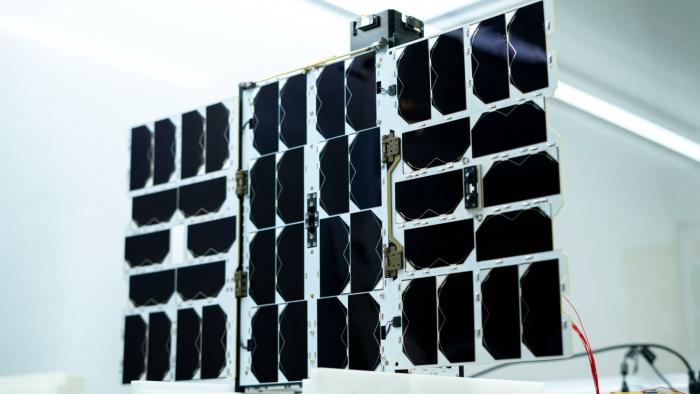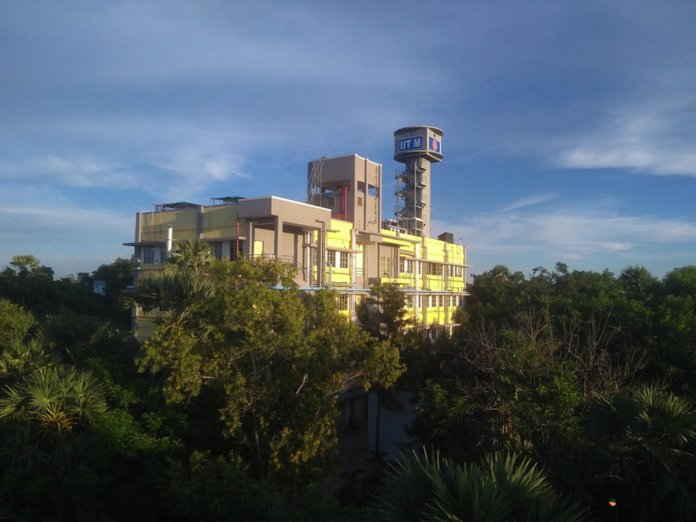Missing Link: India's Space Babies — The Ultrasound of a Huge Future

Camera-constellation for Pixxel's TD-2 satellite
(Bild: Pixxel)
India has sent a craft to the moon. But there’s more happening about space, spilling over into new answers in communication, data apps, sat-imagery, and more.
Note: Eine deutsche Variante dieses Artikel [1] ist ebenfalls verfügbar.
A dingy, dusty, and drab room changed into a make-shift lab. This is where those two boys meet for the first time. The ones who started it all. As shown in a hit series Rocket Boys about India's Space explorers Homi J Bhaba and Vikram A Sarabhai, this is where India's ambitious, encounter with Space science began. Both were young, experimentative and passionate-about-science boys, who shook hands for the first time as Bhaba (1909-1966) interviewed Sarabhai (1919-1971) for a research project. Their minds instantly clicked.
They did a lot of path-breaking work together. They were sort of soul-mates when it comes to the spirit of enquiry and unrelenting rigour for research. Yet, on many subject, they never saw eye to eye. Like the 'Final Parsec problem', they always stood 'just a few light years' apart in their perspectives on how to use nuclear science and physics. One fought for India's energy independence and the other pursued the less-trodden pavement of solving problems of the 'everyday Indian'. But they stood friends till the end. Today, if they were to visit any other small lab in India – they might change their minds and shake hands again. Here's why.
Making space for 'Space'
Not that dusty. Not that dingy. But there are many rooms in India right now where innovators are happily-busy with heads buried into new ideas, prototypes and pilots for, and beyond, space exploration. At the Institutes of Eminence research centre on Extra Terrestrial Manufacturing (ExTeM), researchers are working on developing technologies for manufacturing in space, from hybrid-3D printing metals to synthesizing crystals and biologicals.
Sathyan Subbiah, professor at the ExTeM Research Group at the Indian Institute of Technology Madras, lets on how several tests are conducted in the micro-gravity drop tower on his campus. "We are having discussions for new start-ups that offer microgravity platform services such as parabolic flights; we are also working with start-ups such as Vellon Space planning tests in orbit."
Then there is rocket-engineer-turned-space-entrepreneur Pawan Chandana who came together with experts in solid propulsion and cryogenic rocket technology to launch Skyroot Aerospace. That venture is set for designing and building space launch vehicles in the Indian private space sector. It is already celebrating many count-downs and has recently completed a full-duration test of the third stage of its Vikram-I launch vehicle.
Not far away, in Hyderabad, students make products for agriculture drones using autonomous flight technology and programmable controllers put together with GPS. Students at Gandhi Institute of Technology and Management Deemed University have already taken off the ground with a venture named Mydhili Aerospace. There is also the Agnikul rocket, incubated in a university in Madras, which is working on making highly-customisable two-stage launch vehicles – ready with access to over ten launch-pads and 25 more on the way. This start-up is promising a Launch-When-You-Want capability where payload integration to launch won’t take more than two weeks.
Efficiency Writ Large
From new-age space cartographers like Digantara to hyperspectral earth imaging satellites for space data like Pixxel, many ventures and explorers are eyeing the once-elusive frontiers of space. Pixxel's low-orbit imaging satellite was carried by SpaceX in 2022. More satellites from Pixxel will be sent this year, giving it a daily global coverage by early 2024. Similarly, KaleidEO is aiming for aerial testing of its high-resolution high-swath optical and multi-spectral sensors very soon, leading to manufacturing of the satellites and their sensors.
These launches could not have been better-timed. Grand View Research estimates [2] that the global space technology market can reach 732 billion US-Dollars by 2030, driven by demand for satellite-based services like telecommunications, broadcasting, weather forecasting, and remote sensing. More so, as smaller satellites pack enhanced manoeuvrability, cost-effectiveness, and rapid deployment options – just the thing that specific applications want.
The global satellite internet market size can hit 18.6 billion dollars by 2030, according to an estimate by Allied Market Reserach [3]. This is a perfect trajectory for India's space edge and age – specially after the splendid success of recent lunar and solar missions. John Strand, CEO of Strand Consult, notes how the satellite industry has gone through a revolution where the cost of launching satellites has plummeted. "The price of heavy launches to low earth orbit has fallen from 65,000 dollars per kilogram to 1,500 dollars per kilogram", Strand notes.

(Bild: IIT Madras)
Ask Pradeep Gupta, a former member of India's government and the founder of the think-tank Security and Policy Initiatives; he will tell you how private participation in Indian space forays is worth emulating by other sectors. Especially, as the country has set up the Indian National Space Promotion and Authorisation Centre (IN-SPACe) to facilitate cooperation with private industries. been set up.
Yerramreddy Nivesh Reddy, founder and CEO of Mydhili Aero Space says, "Beyond commercial space travel, we foresee applications in areas like software defined networking (SDN) and edge data centres, which can revolutionise communication and data processing." Another way to confirm this pattern is by looking at the venture capital space. Smita Pawar of the venture capital investor Hyderabad Angels avers that there is a lot of innovation happening in this space. "Many start-ups (from payloads to emerging space-tech) are emerging. They are at a nascent stage, but will soon catch the eyes of investors as they take-off further." Pawan Chandana, co-founder and CEO of Skyroot Aerospace, adds: "India's recent achievements should bolster global investor confidence in India's burgeoning space industry, including the private sector, thus attracting more global joint ventures, investment, collaboration and partnerships."
Two Orbits Intersect: Local + Social
Indigenisation is the key propellant of India's space milestones. The country is catching the global spotlight not just because how fast, or successful, its missions are; more important is how cost-effective they are. Indian teams have cracked the recipe of affordability in space exploration. Something that the world wants to learn more about.
Aditya-L1, a satellite dedicated to comprehensive study of the Sun [4], has seven distinct payloads. All have been developed indigenously, five by the public Indian Space Research Organisation (ISRO), two by Indian academic institutes in collaboration with ISRO. Chandrayaan-3 recently demonstrated Indian capability in safe landing and roving on the lunar surface [5]. It entailed an indigenous lander module (LM), propulsion module (PM). and a rover.
The rocket engine Dhawan-1, which Skyroot test fired in November 2021, has been developed using 3D printing technology. Chandana highlights that the growth of the sector is underpinned by the immense talent pool that India has, the cost-effective and indigenous technology that the country possesses, and the forward vision of the governments which support and lead its journey of growth: "The recent successes highlight India's cost-efficient hardware and highly-reliable space technology capabilities."
That’s where Bhaba would feel happy. And Sarabhai would not be disappointed either, because all these crusades address many on-the-ground issues too. Space exploration leaves a lot of by-products in areas like satellite telephony, alternative fuels, daily-use innovations, and satellite-data applications for agriculture and infrastructure.
In the Fast Lane

(Bild: IIT Madras)
If the last decade was a 'lost decade', this one is taking us light-years ahead, remarks Indranil Bandyopadhyay, principal analyst at Forrester. "Remember how prime minister Modi encouraged ISRO to go on despite some hiccups seen in the last few years? That's the overall spirit of Indian space ambitions. We are learning fast and moving fast. The recent successes of missions have unlocked a multiplier effect in the entire ecosystem." Pixxel’s TD-2, for instance, would gather information as critical as natural gas leakages, deforestation, melting ice caps, pollution, and declining crop health.
Being able to predict a famine or a dangerous oil spill will have massive implications for many industries and people. Bandyopadhyay affirms that satellite data is a rich goldmine and many sectors and applications will benefit from it. He quips, "Space is not about rich men's toys anymore." Gupta points out that ISRO plans several satellites in low, mid, and geostationary orbits each, in order to gather real-time information. "There are promising applications in this regard. Internet connectivity will improve due to an increase in the footprint of satellites in remote areas."
Case in point: start-up KaleidEO has built edge algorithms for the detection of clouds, roads, building footprints, and water-bodies, plus templates to detect changes. There is also hope for space-based solar power that may be transmitted to Earth via microwaves or lasers. There are rare minerals in space that could replace silicon and fossil fuels. There is that unique microgravity environment for manufacturing complex and advanced materials in space – something not possible on Earth. The list can go on.
Applications wait to be uncapped – with the use of AI, interplanetary internet infrastructure using laser, deep space networks, and autonomous communication protocols. Looking up there can change a lot on Earth. Specially when done in a bold and cost-effective way.
Not alone, not short-sighted
Remarkably, India is going ahead with the overarching theme of 'One Earth'. Global space-related collaboration could change a lot indeed. Consider how KaleidEO Space Systems, a start-up based out of Bengaluru, collaborated with Satellogic, a satellite constellation and data company from Uruguay, plus hardware for algorithms and implementation support from Spiral Blue, a start-up from Australia. Incidentally, Amazon Web Services (AWS) India also signed a strategic Memorandum of Understanding with ISRO and IN-SPACe to support space-tech innovations through cloud computing. India's space program is for peaceful purposes, reminds Gupta: "The NaviC GPS will give us an edge and may bring other nations also to us to use the same. India is collaborating with the Canadian Space Agency, the European Space Agency, the Japan Aerospace Exploration Agency, the National Aeronautics and Space Administration, and the Russian State Space Corporation."
As Sarabhai put it: "Those who can hear the music amidst all the noise, achieve great things." A lot of minds and hands in India are busy 'creating' music amidst a lot of noise.
(ds [6])
URL dieses Artikels:
https://www.heise.de/-9317445
Links in diesem Artikel:
[1] https://www.heise.de/hintergrund/Missing-Link-Indiens-Weltraum-Startups-reuessieren-mit-Kooperation-und-Effizienz-9318658.html
[2] https://www.grandviewresearch.com/press-release/global-space-technology-market
[3] https://www.alliedmarketresearch.com/satellite-internet-market-A12472
[4] https://www.heise.de/news/Aditya-L1-Indischer-Forschungssatellit-unterwegs-zur-Sonne-9293186.html
[5] https://www.heise.de/news/Chandrayaan-3-Indischer-Lander-Vikram-auf-dem-Mond-gehuepft-9296242.html
[6] mailto:ds@heise.de
Copyright © 2023 Heise Medien